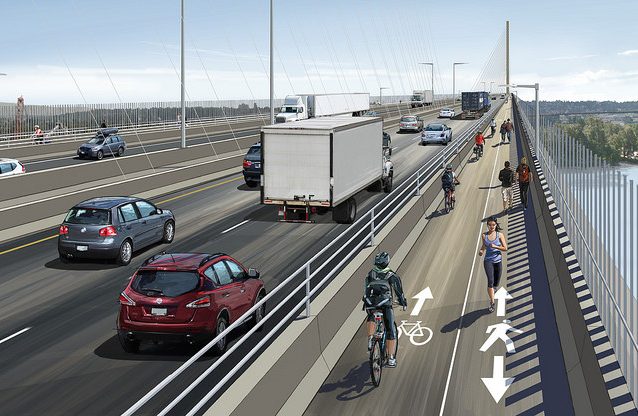
On Friday, March 1, the Province of BC’s Ministry of Transportation and Infrastructure will launch the public engagement portion of their 10-month active transportation strategy, in what could be considered a stealth effort to catch up to years of progress made by municipalities across the south coast.
Public feedback will help identify and prioritize new investments in safe and convenient active transportation infrastructure, education, incentive programs and safety improvements — for modes like walking, cycling, scootering, and skateboarding — for people of all ages and abilities, in communities across the province.
This week, however, as the Ministry encourages stakeholder groups via a widely circulated email to “bring ideas about ways governments can work together to build new infrastructure or better support existing network connections in your community,” news of the strategy and the overall development process is absent from the Ministry’s website.

‘Active Transportation’ — not a subject of note on the Ministry of Transportation and Infrastructure website.
Active transportation is not a topic on the Ministry’s website index. A search for the phrase ‘active transportation strategy’, or variations thereof, yield no meaningful results on the site. The Province doesn’t even rank in Google search results for similar terms, casting doubt on their leadership in this regard.
Based on the Ministry’s multi-decade legacy of active transportation neglect — many British Columbians above a certain age still call it the ‘Ministry of Highways’, and for good reason — this information vacuum isn’t a shocker.
But if the INSTPP process initiated last year by the Province is any indication, there’s hope for new policies, updated strategies, and reprioritization of dollars. And almost halfway through the coalition government’s mandate, a new focus on active transportation, however poorly communicated, can only be a good thing.
It is expected the Ministry’s office will release and promote a website for gathering public feedback by Friday.
Stakeholders, such as community and advocacy groups, have been invited to in-person consultations with the province that begin this Friday in Surrey, and continue over the following two weeks in Vancouver, Penticton, Courtenay, Nelson, Terrace, Prince George and Victoria.
What questions will be asked of stakeholders at these regional forums? In their email, the Ministry has shared the following prep questions:
- How important is active transportation in your community today?
- What are the barriers to active transportation?
- What opportunities do you see to increase active transportation?
- How can the province, communities, community organizations and individuals work together to advance active transportation throughout the province?
Are you a leader within an organization focused on health, transportation, physical activity and community, and have not yet been invited to register for a forum? Email the Ministry’s active transportation strategy team at ActiveTransportation@gov.bc.ca.

BC Ministry of Transportation and Infrastructure — 2018-19 active transportation strategy timeline












Is there a website for ONLINE feedback ?
Why isn’t the priority walking, biking, public transport, car sharing and private car ownership in that order. They just approved 100s of millions to subsidize private electricit vehicles and 100% of the potello bridge replacement. But yet they struggle to find 33 to 40% of skytrain extensions to ubc or Langley. While almost no funds for walking and biking.
That is what I will say.
You can walk or bike almost anywhere today.
Even on SW Marine Drive (from UBC to Granville Street) which ought to be a 3 lane road with counter-flow lanes while clogging traffic for hours !
The allocation to RAPID transit and to new roads, tunnels or bridges is not nearly high enough. One reason to fix this is to toll bridges, key roads and tunnels.
For example: Why is S-Granville from exiting Granville bridge to 16th not a tunnel to make that portion of Granville a shopping & pedestrian area ? Why is LionsGate not a 6 lane triple decker ? Where is the Boundary Road bridge over the Fraser to connect with Richmond highways ? Why is Boundary Road not a Highway? Where is the Massey tunnel widening ? Why is Hwy 1 to Chilliwack not 6 lanes from Surrey ? Why do we start Jericho land planning but have no rapid transit plan in place ?
Why is everything in your post, after your first sentence, about topics other than Active Transportation? That is, after all, the topic here.
You can walk or bike almost anywhere —— but it is often NOT a pleasant or safe experience .
The British Columbia Cycling Coalition shared this survey question from the province:
“Question 1: What does active transportation mean to you and how does it fit into your life?
March 1, 2019
The Province has been supporting active transportation since the mid 1990’s when it first launched the Bike to Work program in 1994 and provided funding for Cycling Network planning in 1995. More recently, communities across the province have benefited from BikeBC grants that were initiated in 2008.
Communities around the province have also independently embraced active transportation by developing specific active transportation plans or including active transportation in their official community plans (OCP). Today, governments, communities, environmental groups and community organizations are all embracing active transportation. The active transportation conversation will build on this work and provide a provincial framework to advance active transportation throughout the province.
The development of the framework for active transportation is a collaborative process, involving a wide range of public, private, non-profit and Indigenous community participants. Active transportation will support the Province’s three key commitments to British Columbians: to make life more affordable, to deliver the services people count on, and to build a strong, sustainable economy.
All feedback received will result in a provincial approach with measures to support new infrastructure, education and incentive programs, and safety improvements for people using active transportation.
Question 1: What does active transportation mean to you and how does it fit into your life?”
Give them your answer at https://engage.gov.bc.ca/activetransportation/2019/03/01/question1